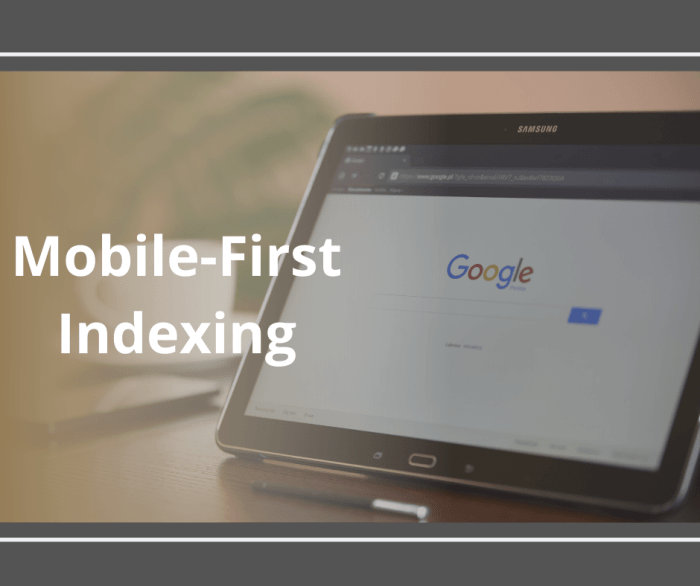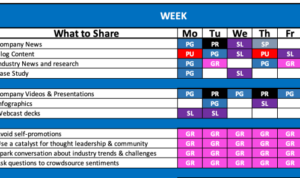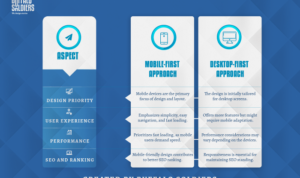Optimizing for Google’s Mobile-First Index dives into the world of mobile , shedding light on the crucial aspects that impact search rankings. From understanding the importance of mobile optimization to exploring key strategies, this topic is a must-know for anyone looking to dominate the digital landscape.
When it comes to mobile , staying ahead of the curve is essential. By mastering the art of optimizing for Google’s Mobile-First Index, you’re setting yourself up for success in the competitive online realm.
Understanding Google’s Mobile-First Index: Optimizing For Google’s Mobile-First Index
When it comes to Google’s Mobile-First Index, it’s all about prioritizing mobile-friendly websites in search rankings. This means that Google now primarily uses the mobile version of a site for indexing and ranking, considering how a site performs and looks on mobile devices before desktop.
Importance of Optimizing for Mobile Devices
Optimizing your website for mobile devices is crucial in today’s digital landscape. With the majority of internet users accessing content on their smartphones and tablets, having a mobile-friendly site is essential for providing a seamless user experience. Not only does it improve user satisfaction, but it also helps in boosting your search engine rankings.
Shift Towards Mobile-Friendly Websites
In recent years, search engines like Google have been placing a strong emphasis on mobile-friendly websites. This shift is a response to the increasing number of users browsing the web on their mobile devices. By prioritizing mobile-friendly sites, search engines aim to deliver relevant and optimized results to users, ensuring a better overall browsing experience.
Key Factors for Optimizing for Google’s Mobile-First Index

When it comes to optimizing for Google’s Mobile-First Index, there are several key factors that play a crucial role in ensuring your website ranks well on mobile devices. From responsive design to mobile-friendly content, each element contributes to enhancing your mobile search performance.
Responsive Design
- Responsive design ensures that your website adapts to different screen sizes and resolutions, providing a seamless user experience across all devices.
- Google prioritizes websites that are mobile-friendly, and having a responsive design is a crucial factor in ranking well on mobile searches.
- By implementing responsive design, you not only improve user experience but also increase the chances of your content being discovered on mobile devices.
Fast Loading Speed
- Fast loading speed is essential for mobile optimization, as users expect quick access to information on their smartphones and tablets.
- Google considers page speed as a ranking factor, especially for mobile searches, so optimizing your website for speed is crucial.
- By reducing loading times, you can improve user engagement and decrease bounce rates, ultimately benefiting your mobile search performance.
Mobile-Friendly Content
- Creating mobile-friendly content involves optimizing text, images, and videos for smaller screens to ensure readability and accessibility.
- Google rewards websites that provide valuable and easily consumable content on mobile devices, leading to higher rankings in mobile search results.
- By focusing on mobile-friendly content, you can enhance user experience and increase the likelihood of users engaging with your website on mobile.
Structured Data and Metadata, Optimizing for Google’s Mobile-First Index
- Structured data helps search engines understand the context of your content, making it easier for them to display relevant information in search results.
- By implementing structured data and optimizing metadata for mobile, you can improve the visibility of your website and attract more mobile users.
- Including structured data markup and relevant metadata enhances the overall mobile search performance of your website, positively impacting your rankings.
Strategies for Mobile Optimization

Creating a mobile-friendly website layout is essential in today’s digital landscape. With more and more users accessing websites on their mobile devices, it is crucial to ensure that your site is optimized for mobile viewing. Here are some best practices to help you create a mobile-friendly website layout:
Best Practices for Creating a Mobile-Friendly Website Layout
- Use a responsive design that adapts to different screen sizes and resolutions.
- Optimize images and videos for mobile viewing to reduce load times.
- Ensure that text is easily readable without zooming in.
- Keep menus and navigation simple and easy to use on a touchscreen.
- Avoid pop-ups and interstitials that can be difficult to close on mobile devices.
Improving mobile page speed and performance is another crucial aspect of mobile optimization. Users expect fast-loading websites on their mobile devices, and a slow site can lead to high bounce rates. Here are some tips to help you improve mobile page speed and performance:
Tips for Improving Mobile Page Speed and Performance
- Optimize images and videos for mobile devices by compressing files and using the correct formats.
- Minimize HTTP requests by combining CSS and JavaScript files.
- Leverage browser caching to reduce load times for returning visitors.
- Use a content delivery network (CDN) to serve content from servers closer to the user’s location.
- Avoid excessive use of plugins and scripts that can slow down your site.
Using AMP (Accelerated Mobile Pages) can significantly improve mobile optimization by creating fast-loading, streamlined versions of your webpages. AMP pages are designed to load quickly on mobile devices, providing a better user experience and potentially improving your search engine rankings. Here’s why using AMP is important for better mobile optimization:
Importance of Using AMP for Better Mobile Optimization
- AMP pages load almost instantly, reducing bounce rates and keeping users engaged.
- Google prioritizes AMP pages in search results, leading to potential visibility and traffic gains.
- AMP is an open-source project supported by major tech companies like Google, making it a reliable and future-proof solution for mobile optimization.
- Implementing AMP can improve your site’s performance on slow mobile networks, ensuring a seamless user experience for all visitors.
Testing and Monitoring Mobile Optimization
When it comes to ensuring your website is mobile-friendly and optimized for Google’s Mobile-First Index, testing and monitoring are crucial steps in the process. By regularly checking your site’s mobile performance, you can identify areas that need improvement and make necessary adjustments to maintain visibility in mobile search results.
Testing a Website’s Mobile-Friendliness
To test your website’s mobile-friendliness, you can use Google’s Mobile-Friendly Test tool. Simply enter your website’s URL, and the tool will analyze your site’s mobile compatibility, highlighting any issues that need to be addressed. Additionally, you can manually test your website on various mobile devices to ensure a seamless user experience across different screen sizes.
Tools and Techniques for Monitoring Mobile Performance
There are several tools available to help you monitor your website’s mobile performance, such as Google’s PageSpeed Insights and Mobile Usability Report. These tools provide insights into your site’s loading speed, mobile responsiveness, and overall user experience. You can also utilize heatmaps and user behavior tracking to identify areas of your site that may need improvement.
Significance of Ongoing Testing and Optimization
Ongoing testing and optimization are essential for maintaining visibility in mobile search results. As technology evolves and user behavior changes, it’s crucial to regularly test your website’s mobile-friendliness and make necessary optimizations. By staying ahead of mobile trends and continuously improving your site’s mobile performance, you can ensure that your website remains competitive and accessible to mobile users.






